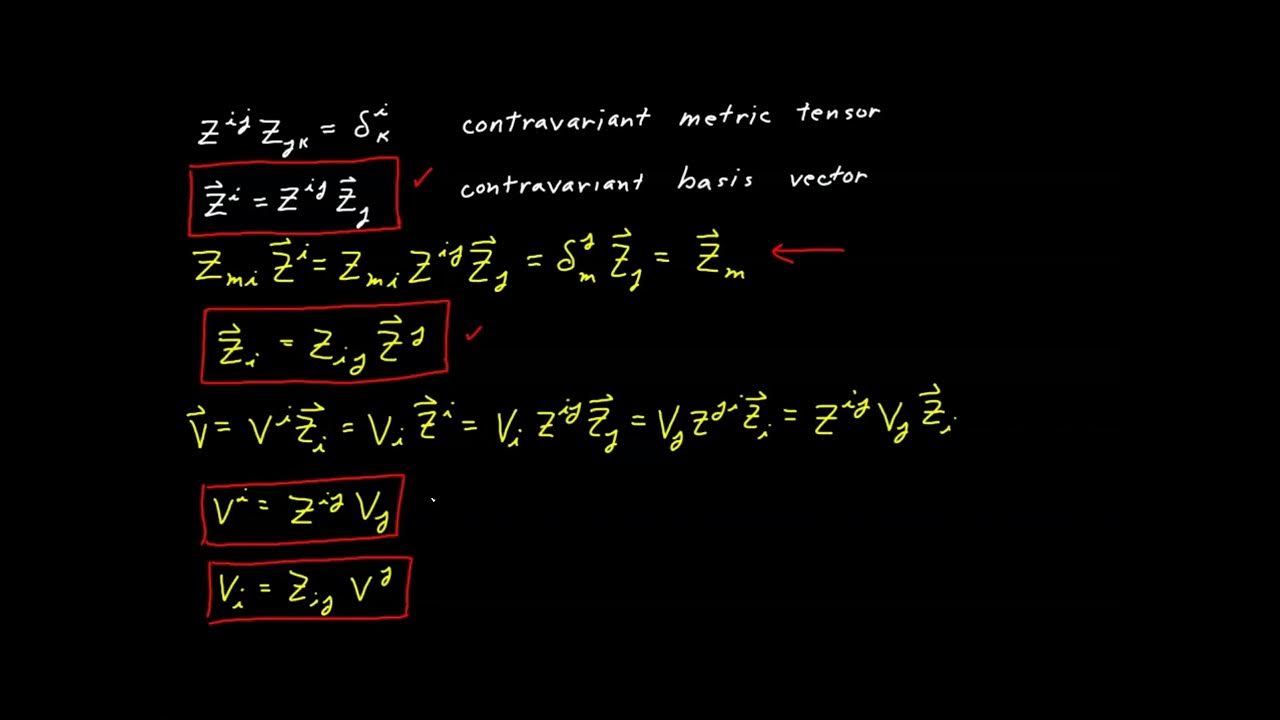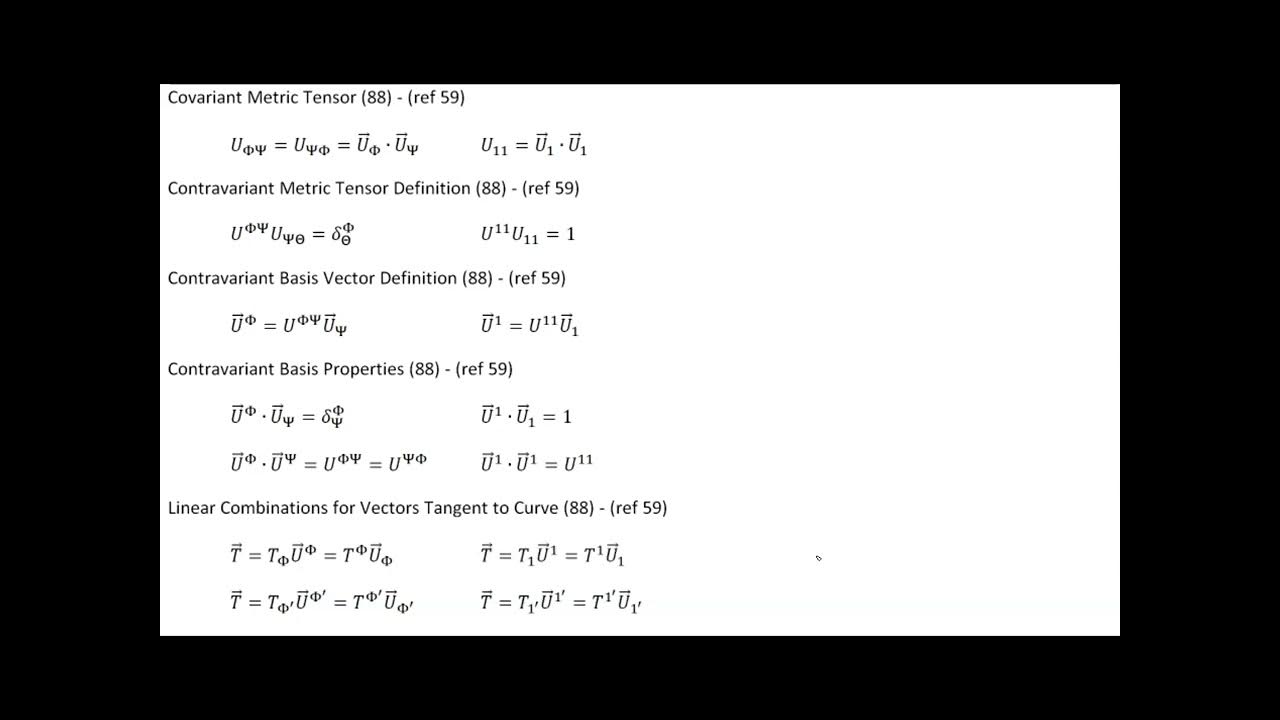Tensor Calculus 4f: The Relationship Between the Covariant and the Contravariant Bases
TLDRThis lecture delves into the fundamental relationship between contravariant and covariant basis vectors, crucial for understanding metric tensors in differential geometry. The contravariant metric tensor is defined as the inverse of the covariant one, and this relationship is key to deriving the contravariant basis elements. The lecture clarifies that this relationship inherently implies orthogonality between the basis elements when they have different indices, and it also touches on the implications for their lengths. The explanation is aimed at demystifying the concepts and providing a clear visual representation of the orthogonality in two dimensions.
Takeaways
- 📚 The script discusses the relationship between contravariant and covariant bases in the context of metric tensors, a topic the lecturer admits may not have been fully justified in previous lectures.
- 🔍 The lecturer intends to dedicate a video to this important relationship, which will later be seen as a special case of index juggling in tensor analysis.
- 📐 The contravariant metric tensor is defined as the matrix inverse of the covariant metric tensor, which is a fundamental concept in understanding their relationship.
- 🔑 The contravariant basis element is defined through a contraction between the covariant basis element and the contravariant metric tensor.
- 📈 The script derives the relationship by showing that dotting the contravariant metric tensor with a covariant basis element results in the Kronecker delta, indicating orthogonality.
- 📊 The relationship implies that contravariant basis elements are orthogonal to covariant basis elements with different indices, and their inner product is one if the indices match, otherwise it's zero.
- 📏 The lecturer uses a two-dimensional illustration to explain how the contravariant and covariant basis elements would be drawn in an orthogonal fashion.
- 📐 The angle between the covariant and contravariant basis elements should be between zero and π/2 to ensure the inner product is positive one.
- 📘 The script highlights that once you have the covariant basis, you can infer the contravariant basis and vice versa due to their orthogonal relationship.
- 📌 An additional note is made about the lengths of the basis elements: if the length of a covariant basis element is less than one, the length of its contravariant counterpart must be greater than one, due to their dot product being one.
- 📝 The lecturer concludes by emphasizing the ease of deriving this relationship and its implications for the orthogonality between elements of covariant and contravariant bases.
Q & A
What is the main topic discussed in the video script?
-The main topic discussed in the video script is the relationship between contravariant and covariant bases in the context of metric tensors.
Why is the relationship between contravariant and covariant metric tensors important?
-The relationship between contravariant and covariant metric tensors is important because it is fundamental to the understanding of index juggling and the properties of space in differential geometry.
How is the contravariant metric tensor defined in relation to the covariant metric tensor?
-The contravariant metric tensor is defined as the matrix inverse of the covariant metric tensor.
What is the definition of a contravariant basis element?
-The contravariant basis element is defined as a contraction between the covariant basis element and the contravariant metric tensor.
How does the relationship between contravariant and covariant bases imply orthogonality?
-The relationship implies orthogonality because each contravariant basis element is orthogonal to the covariant basis element with different indices, and their inner product is zero unless the indices are the same, in which case it is one.
What does the script suggest about the visualization of contravariant and covariant bases in two dimensions?
-The script suggests that in two dimensions, the contravariant basis elements can be visualized as being orthogonal to the covariant basis elements with different indices.
What is the significance of the dot product in the relationship between contravariant and covariant basis elements?
-The dot product is significant because it is used to define the inner product between the basis elements, which in turn determines whether they are orthogonal or parallel.
How does the script explain the relationship between the lengths of contravariant and covariant basis elements?
-The script explains that if the length of a covariant basis element is less than one, then the length of the corresponding contravariant basis element is greater than one, due to their dot product being equal to one.
What is the role of the metric tensor in the definition of contravariant and covariant basis elements?
-The metric tensor plays a crucial role in defining the contravariant basis elements through contraction with the covariant basis elements, and it is also used to define the contravariant metric tensor as the inverse of the covariant metric tensor.
Why might the script mention that the relationship between contravariant and covariant bases is not mysterious?
-The script mentions that the relationship is not mysterious because it is a direct consequence of the definitions of the contravariant and covariant basis elements and the metric tensors.
Outlines
📚 The Relationship Between Covariant and Contravariant Bases
This paragraph delves into the fundamental relationship between covariant and contravariant bases in the context of metric tensors. It clarifies that the contravariant metric tensor is defined as the inverse of the covariant metric tensor. The explanation highlights the logical necessity of this relationship before introducing index juggling, which will later be shown as a special case of this relationship. The paragraph also discusses how the contravariant basis element is derived from the contraction between the covariant basis element and the contravariant metric tensor. The importance of this relationship in implying orthogonality between different basis elements is emphasized, with a visual representation in two dimensions to illustrate the orthogonal nature of these elements.
📐 Orthogonality and Length Relationships of Basis Elements
Building upon the previous discussion, this paragraph focuses on the orthogonality and the geometric implications of the covariant and contravariant basis elements. It explains that the contravariant basis elements are orthogonal to the covariant ones when they have different indices, with the inner product being zero. Conversely, when the indices match, the inner product is one, indicating that the elements are parallel. The paragraph further explores the relationship between the lengths of the basis elements, noting that if the length of a covariant basis element is less than one, the corresponding contravariant element's length must be greater than one, due to their dot product being one. This insight adds a layer of understanding to the geometric interpretation of these mathematical constructs.
Mindmap
Keywords
💡Contravariant and Covariant Bases
💡Metric Tensors
💡Index Juggling
💡Orthogonality
💡Dot Product
💡Kronecker Delta
💡Inverse Matrix
💡Tensor
💡Basis Element
💡Dimension
💡Length of a Vector
Highlights
The relationship between contravariant and covariant bases is discussed without prior justification in the lectures.
Index juggling is introduced as a special case of the relationship between metric tensors.
The contravariant metric tensor is defined as the inverse of the covariant metric tensor.
The contravariant basis element is defined through a contraction with the covariant basis element and the contravariant metric tensor.
The dot product between the covariant and contravariant basis elements is equivalent to the Kronecker delta.
Orthogonality is implied by the relationship between the covariant and contravariant basis elements.
Each contravariant basis element is orthogonal to the covariant basis element with different indices.
The inner product of the same contravariant and covariant basis elements is one.
The contravariant basis can be visualized as orthogonal to the covariant basis in two dimensions.
The angle between the covariant and contravariant basis elements should be between zero and Pi/2 for the dot product to be positive one.
The contravariant basis can be drawn once the covariant basis is known, and vice versa.
The length of the contravariant basis element is inversely proportional to the length of the covariant basis element if their dot product equals one.
The product of the lengths of the covariant and contravariant basis elements must be greater than or equal to one.
The relationship between the covariant and contravariant basis elements is fundamental and easy to derive.
The lecture aims to clarify the relationship between the covariant and contravariant basis elements and their implications for orthogonality.
Transcripts
5.0 / 5 (0 votes)
Thanks for rating:





